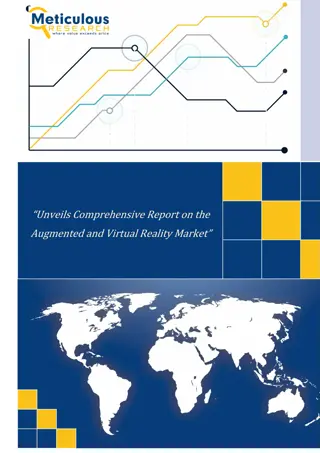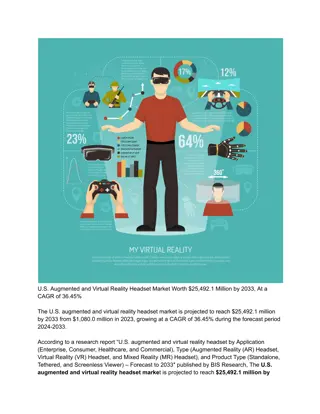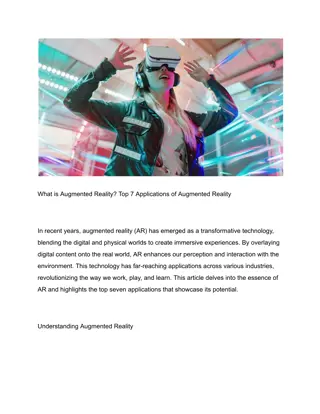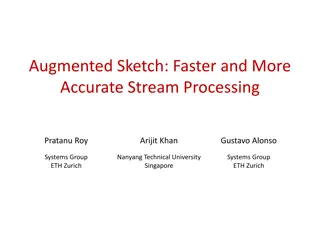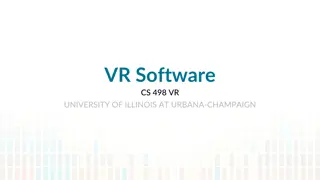Comparing Virtual Reality (VR), Augmented Reality (AR), and Mixed Reality (MR)
Virtual Reality (VR) immerses users in a digital environment using headsets, Augmented Reality (AR) overlays computer-generated content on the real world, and Mixed Reality (MR) combines digital content with real-world interactions through wearable devices like glasses. VR isolates users, AR enhances experiences, and MR blends digital media with real-world elements, offering an interactive and enriched environment. Various VR headsets are available, AR can be experienced through smart glasses or smartphone apps, and MR devices are in the research phase, typically using transparent wearable glasses. Technology giants manufacture VR headsets, while AR products include smart glasses and smartphone AR. MR intertwines immersive media and spatial computing to interact with the user's environment.
Download Presentation

Please find below an Image/Link to download the presentation.
The content on the website is provided AS IS for your information and personal use only. It may not be sold, licensed, or shared on other websites without obtaining consent from the author. Download presentation by click this link. If you encounter any issues during the download, it is possible that the publisher has removed the file from their server.
E N D
Presentation Transcript
Chapter 5 How do we Compare: Virtual reality (VR) Augmented Reality (AR) Mixed reality (MR)
Comparison Virtual Reality (VR) encompasses immersive experiences and content via a VR headset or HMD (head-mounted display). The content is 100% digital and computer-generated. The current reality is replaced with a new 3D digital environment in which the user is isolated from the real world.
Comparison Some VR headsets manufacturers include technology giants such as:- Facebook (through their acquisition of Oculus), Google (with a series of Daydream headsets), HTC (VIVE), Samsung (Gear VR), and Windows (who have named their range of devices Windows Mixed Reality, even though a number is VR-only enabled.)
Comparison There are three types of VR devices available these are:- Tethered, Stand-alone, and Smartphone VR
Augmented reality (AR) Overlays computer-generated content on top of the real world. It can superficially interact with the environment in real-time. Is primarily experienced via a wearable glass device or through smartphone applications
Augmented reality (AR) Augmented content doesn t recognize or interact with the physical objects within a real-world environment, however, it does enhance the user s experience
Augmented reality (AR) Some of the categories of AR products are wearable AR glass (smart glass), smartphone AR and other AR headsets
Mixed reality (MR) Combines several technologies into one wearable device. Immersive media, spatial computing, and hybrid reality intertwine digital content while interacting with a user s real-world environment. It allows for digital content to integrate, enrich and interact with the user s real-world environment. MR lenses or headsets present an overlay of digital content that interacts with objects in the real world in real-time. The products are, in most cases, in the research and development phase, but MR is viewed through transparent wearable glasses
Mixed reality (MR) Mixed Reality removes the boundaries between real and virtual worlds using occlusion: the computer-generated objects can be visibly obscured by objects in the physical environment from the user s point of view Some of MR products are Microsoft's hololens, magic leaps and other MR devices
DIFFERENCES BETWEEN VR, AR, AND MR Virtual Reality: VR is content which is 100% digital and can be enjoyed in a fully immersive environment. Augmented Reality: AR overlays digital content on top of the real-world. Mixed Reality: MR is a digital overlay that allows interactive virtual elements to integrate and interact with the real-world environment.
DIFFERENCES AR is a variation of the more known concept of Virtual Reality Technology (VR), which is often defined as the use of real-time digital computers and other special hardware and software to generate a simulation of an alternate world or environment, which is believable as real or true by the users . VR technology creates an environment in which the user feels and seems to be moving inside a computer- created virtual world in the same way people move inside the natural environment; while immersed in the virtual world, the user cannot perceive the real one which still surrounds him. On the contrary, AR allows the user to see the real world, augmenting it with superimposed virtual objects. In other words, while VR replaces reality, AR supplements it, creating an environment in which real and virtual objects harmonically coexist. AR exploits users perceptual-motor skills in the real world, creating a special type of human-machine interaction
Relation between AR and Telepresence In telepresence, the fundamental purpose is to extend the operator s sensory-motor facilities and problem-solving abilities to a remote environment. Virtual reality aims to achieve the illusion of presence within a computer simulation whereas telepresence aims to achieve the illusion of presence at a remote location. AR can be considered a technology between VR and Telepresence. In VR the environment is completely synthetic In Telepresence it is completely real, In AR the user sees the real world augmented with virtual objects.
The architecture of AR systems Scene Generator Tracking System Display
AR Architecture AR System clients provide the user interface. The Mid Tier makes the user interface available in browsers. The AR System server implements the workflow functions, access control, and flow of data into and out of the database. The database server acts as a data storage and retrieval engine
Functionally the AR System consists of three environments Presentation Business Processing Data Storage
AR System clients AR System clients can be broadly divided into user client and developer clients
Four major classes of AR distinguished by their display type Optical SeeThrough, Virtual Retinal Systems, Video See-Through, Monitor Based AR and Projector Based AR
Application of AR systems Education, Medical, Assistance, Entertainment








